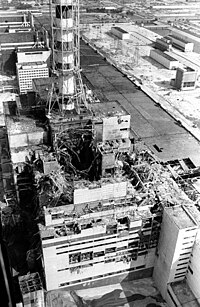
Photo from wikipedia
In their natural habitats, populations of organisms are faced with different levels of chronic low‐intensity radiation, causing a wide range of radiobiological effects (from radiosensitivity to radioadaptive response and hormesis).… Click to show full abstract
In their natural habitats, populations of organisms are faced with different levels of chronic low‐intensity radiation, causing a wide range of radiobiological effects (from radiosensitivity to radioadaptive response and hormesis). In this study, specimens of Drosophila melanogaster were selected from territories of the Chernobyl nuclear power plant with different levels of radioactive contamination. The isogenic stocks derived from these specimens represent the genetic systems of current populations and make it possible to study radioresistance and its mechanisms in future generations under controlled laboratory conditions. Previous studies have shown that transgenerational radiation effects at the level of lethal mutations and survival rate are unstable and depend not only on the level of chronic low‐intensity irradiation, but also on other factors. A single acute irradiation exposure of offspring whose parents inhabited a site with a higher level of chronic irradiation made it possible to reveal pronounced radioresistant features in the offspring. And the offspring whose parents were exposed to radiation levels close to the natural radiation background, on the contrary, acquired radiosensitive features. Their response to acute exposure includes a high‐frequency of lethal mutations and a short lifespan. The differential response to different levels of chronic parental exposure is caused by differences in the activities of certain transposons that destabilize the genome. Our data contribute to the understanding of genetic and epigenetic mechanisms (via transposon activity) of the effect of parental radiation exposure on the health and adaptive potential of populations affected by the technogenically increased radiation background.
Journal Title: Environmental and Molecular Mutagenesis
Year Published: 2022
Link to full text (if available)
Share on Social Media: Sign Up to like & get
recommendations!